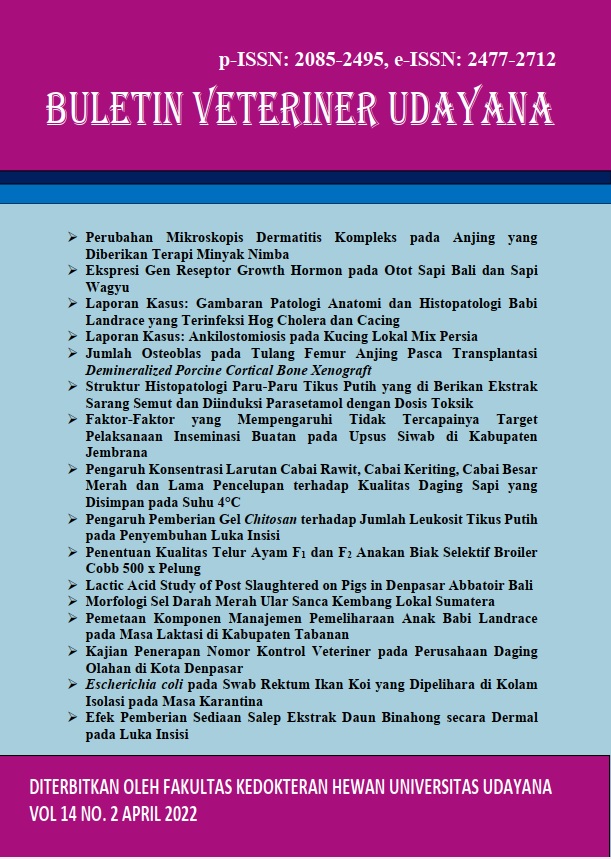ESCHERICHIA COLI IN THE RECTAL SWAB OF KOI FISH MAINTAINED IN ISOLATION PONDS DURING QUARANTINE PERIOD
Abstract
Koi fish (Cyprinus carpio) is one of the freshwater ornamental fish commodities which has a very high economic value and is of high interest. Koi fish are generally transported by land. This condition can cause koi to become stressed, which has an impact on decreasing health and even disease errors. One indicator of koi health problems can be seen from the presence of E. coli. This study aims to see the Escherichia coli bacteria in koi fish kept in isolation ponds during the quarantine period using 19 samples of isolates from rectal swabs which were then taken to BBVET Denpasar for isolation and identification of E. coli bacteria. This study used an exploratory observation design with a cross-sectional method, while the sample was taken by purposive sampling. The data obtained were descriptive qualitative. The result of this study are known from 19 samples that be examined show five samples positive of Escherichia coli bacteria (26,3%) which is three samples (15,9%) came from Tulungagung koi and two samples (10,3%) came from Blitar koi.
Downloads
References
Amalia, Evida, Soeprapto, Hayati, Syakirin MB. 2015. Analisis bakteri Escherichia coli pada budidaya ikan nila (Oreochromis Niloticus) di tambak-tambak Kota Pekalongan. PENA Akuatika. 12 (1): 72-78.
Bastian D. 2018. Gila Koi. Jakarta (ID): Brambuse Printing & Promotion.
Cardoso PH, Moreno AM, Morena LZ, Oliveira CH, Baroni Fd, Maganha SR, Balian SD. 2019. Infectious diseases in aquarium ornamental pet fish: prevention and control measures. Braz. J. Vet. Res. Anim. Sci. 56(2): 1-16.
Chairunnisa S, Setiawan N, Irkham, Ekawati K, Anwar A, Fitri ADP. 2018. Studi tingkah laku ikan terhadap Prototype Auto-Lion (Skala Laboratorium). Marine Fish. 9(1): 53-61.
Dahril I, Tang UM, Putra I. 2017. Pengaruh salinitas berbeda terhadap pertumbuhan dan kelulusanhidupan benih ikan nila merah (Oreochromis sp.). J. Berkala Perikanan Terubuk. 45(3): 67-75.
Efendi M. 2017. Ikan Koi. jakarta timur: Penebar Swadaya.
El-Deen AG, Rawway M. (2014). Study on some aerobic bacterial species in ornamental fish. Assiut Vet. Med. J. 60(143): 156-164.
Fitriadi MW, Basuki F, Nugroho RA. 2014. Pengaruh pemberian recombinant growth hormone (rgh) melalui metode oral dengan interval waktu yang berbeda terhadap kelulushidupan dan pertumbuhan larva ikan gurame var bastard (Osphronemus gouramy Lac, 1801). J. Aquac. Manag. Technol. 3(2): 77-85.
Hardiko Y J, Hidayat N, Cholissodin I. 2018. Diagnosis penyakit ikan koi menggunakan metode naive bayes classifier. J. Pengembangan Teknol. Inform. Ilmu Komp. 2(11): 5310-5316.
Hossain MS, Hashem S, Halim MA, Chowdhury P, Sultana S, Khan MNA. 2017. Bacterial community structure and infection in cultured koi (Anabas Testudineus) fish species. Int. J. Fish. Aquatic Stud. 5(3): 520-524.
Iqbal Z, Sajjad R. 2013. Some pathogenic fungi parasitizing two exotic tropical ornamental fishes. Int. J. Agric. Biol. 15(3): 595-598.
Jawetz, Melnick, Adelberg. 2008. Mikrobiologi Kedokteran. 23th Ed, Translation of Jawetz, Melnick, and Adelberg’s Medical Microbiology, Alih bahasa oleh Hartanto, H., et al. Jakarta: EGC.
Kurniati E, Huy VT, Anugroho F, Sulianto AA, Amalia N, Nadhifa AR. 2020. Analisis pengaruh pH dan suhu pada desinfeksi air menggunakan microbubble dan karbondioksida bertekanan. J. Nat. Res. Environ. Manag. 10(2): 247-256.
Lemeshow. 1997. Besar Sampel Dalam Penelitian Kesehatan. Yogyakarta, UGM
Madyowati SO, Muhajir. 2018. Respon stressor kepadatan ikan mas (Cyprinus carpio L) setelah diinfeksi bakteri edwardsiella tarda secara buatan terhadap nilai hematokrit. Proc. Sem. Nas. Kelautan Perikanan. 4: 311-318.
Maruka SS, Siswohutomo G, Rahmatu RD. 2017. Identifikasi cemaran bakteri Escherichia coli pada ikan layang (Decapterus russelli) segar di berbagai pasar Kota Palu. J. Mitra Sains. 5(1): 84-89.
Mirzaei M, Khovand H. 2015. Prevalence of argulus foliaceus in ornamental fishes, goldfish (Carassius auratus) and koi (Cyprinus caprio) in Kerman, southeast of Iran. J. Parasit Dis. 39(4): 780-782.
Restina D, Ramadhian MR, Soleha TU, Warganegara E. 2019. Identifikasi bakteri Escherichia coli pada air PDAM dan air sumur di Kelurahan Gedong Air Bandar Lampung. Agromedicine. 6(1): 58-62.
Sarjito, Prayitno SB, Haditomo AH. 2013. Buku Pengantar Parasit Dan Penyakit Ikan. Semarang: UPT UNDIP Press.
Saridewi I, Pambudi A, Ningrum YF. 2016. Analisis bakteri Escherichia coli pada makanan siap saji di Kantin Rumah Sakit X dan kantin Rumah Sakit Y. J. Biol. Indon. 12(2): 21-34.
Solichin A, Widyorini N, Wijayanto DSM. 2013. Pengaruh ekstrak bawang putih (Allium sativum) dengan dosis yang berbeda terhadap lepasnya suckers kutu ikan (Argulus sp.) pada ikan koi (Cyprinus carpio). J. Manag. Aquatic Res. 2(2): 46-53.
Suparjo MN. 2010. Kerusakan jaringan insang ikan nila (Oreochromis niloticus L) akibat deterjen. J. Sain. Tek. Perikanan. 5(2): 1-7.
Supono. 2015. Manajemen Lingkungan untuk Akuakultur. Yogyakarta: Plantaxia. ISBN: 978-602-6912-04-6.
Suwarsito, Mustafidah H. 2011. Diagnosa penyakit ikan menggunakan sistem pakar. JUITA. 1(4): 131.
Utami DAT, Aida Y, Pranata F, Sinung. 2013. Variasi kombinasi tepung labu kuning (Cucurbita moschata d.) dan tepung azolla (Azolla pinnata r.br.) pada kecerahan warna ikan mas koi (Cyprinus carpio L.). J. Ilm. Biol. 1-12.
Yanuhar U, Caesar NR, Setiawan F, Sumsanto M, Musa M, Wuragil DK. 2018. The aquatic environmental quality of koi fish (Cyprinus carpio) pond infected by Myxobolus sp. based on the biological status of the phytoplankton. ICAMBBE J. Physics. 1-7.
Yanuhar U, Musa M, Wuragil DK. 2019. Pelatihan dan pendampingan manajemen kualitas air dan kesehatan pada budidaya ikan koi (Cyprinus carpio). J. Karinov. 2(1): 69-74.
Zaman BS, Khatun MM, Islam MA, Sharmin S, Kulsum U, Hoq ME. 2013. Bacterial Flora of Koi (Anabas testudineus) Harvested from Ponds and Their Antibiogram. Microb. Health. 2(1): 8-11.





